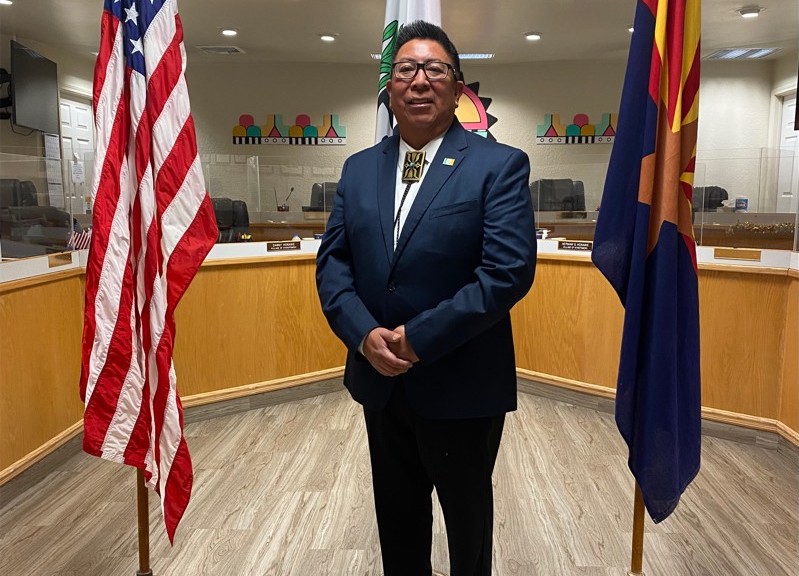
- Details
- By Chez Oxendine
- Energy | Environment
One of the most important tools to any family on the Hopi Tribe's reservation in northeastern Arizona is the refrigerator. Grocery shopping can require up to four hours of driving round-trip, making food storage at home crucial for survival.
Uneven electrification across the reservation frequently threatens precious stored food with brownouts, says Hopi Tribal Chairman Timothy Nuvangyaoma. The tribe was working toward solving those issues with a range of community-scale and utility-scale solar projects that would also replace lost revenues and displaced jobs from the 2019 closure of the Navajo Generating Station coal plant.
Then on July 4, President Donald Trump signed the One Big Beautiful Bill Act — officially House Resolution 1 — eliminating or rescinding key clean energy grant and loan programs used by the Hopi and other tribes to achieve energy sovereignty, enhance economic development, and protect their lands and cultural values.
“We were successful in finding funding for microgrids and other projects to stabilize and provide reliable power for our Hopi people,” Nuvangyaoma said. “Now, with the OBBBA, there’s a lot of uncertainty. We’re disappointed in leaders that don’t look beyond their nose when it comes to those communities that rely on moving forward with this technology. We’re in 2025 right now and we still have homes that are not electrified.”
HR 1 permanently enshrines 2017-era tax cuts and raises the debt ceiling by $4 trillion. To soften a projected $3.4 trillion increase in the federal deficit over the 2025-2034 period, the bill makes cuts across the table, including stiffening work requirements for SNAP and Medicaid. While Indian Country is partially shielded from those cuts — Native communities are exempt from the work requirements — utility-scale Native energy faces cuts.
HR 1 accelerates the phaseout of elective pay tax credits for renewable projects, which could reduce project costs by 30% to 50% by allowing tribes to claim tax refunds on their clean energy buildouts, according to prior Tribal Business News reporting.
The phaseout comes in two forms: Projects that can spend 5% of their budgeted building costs or begin construction by July 4, 2026, can have up to 4 years to put that project in service and still claim the credit. For larger buildouts still in the planning phase unable to meet that goal, they must be in service by the end of 2027. That’s an unworkable time frame for utility-minded projects, according to Cheri Smith, president and CEO of the nonprofit Alliance for Tribal Clean Energy.
“The minimum on most of these projects is five years, and that’s assuming everything goes well,” Smith told Tribal Business News. “You could maybe stand up a project in three to four years if everything’s perfect, but President Trump’s tariffs mean that people have been hoarding parts of the supply chain. There’s substation equipment out there that’s not available for years.”
The grace period afforded to projects that have begun construction by July 2026 means that community-scale builds should still be able to claim the credit, according to attorney Pilar Thomas, partner at Quarles and Brady law firm. Tribes with projects such as rooftop solar for supporting administration buildings or homes should proceed quickly, Thomas told Tribal Business News.
“The One Big Beautiful Bill Act is a big step backwards, but I'm not quite as pessimistic as some, because most tribes are doing smaller projects that can get that 5 percent down or construction started by next year, or be in service by 2027,” Thomas said. “You’ve got to move, but I think tribes are doing mostly smaller projects for themselves, and I think those are still viable.”
There is one bright spot: the bill permanently reauthorizes the New Markets Tax Credit (NMTC) program, which incentivizes private developers to build in underserved areas in exchange for tax credits. While not as generous as the energy-specific credits, NMTCs have already supported some tribal projects, and may account for a little — not all — of the money lost when elective pay goes away, Thomas said.
“In the past, a handful of tribes have financed clean energy with NMTC, and before we were able to get elective pay under the IRA, that was one way to get basically free money for your energy project,” Thomas said. “There are lots of ways to (address these challenges).”
Thomas said she was more concerned about the direct funding cuts, particularly grants, loans and awards that would have provided important pre-development funding, or helped get those projects in motion to claim the tax credits.
HR1 cuts the Department of Energy’s Tribal Energy Loan Guarantee Program, or TELGP. Initially authorized for $2 billion, the program’s capacity swelled to $20 billion under the Inflation Reduction Act.
The law also rescinds any unobligated funding in the Environmental Protection Agency’s Greenhouse Gas Reduction Fund, a $27 billion Biden-era program created to establish green banks and support renewable energy projects in disadvantaged communities. Those cuts could further jeopardize ongoing efforts to recover $20 billion in clean-energy funding awarded under the GGRF’s National Clean Investment Fund (NCIF) and Clean Communities Investment Accelerator (CCIA) programs. In March, the EPA froze the funds — including accounts held at Citibank — and formally terminated the grants. A U.S. District Court quickly issued a temporary restraining order, finding the EPA acted unlawfully. The EPA’s attempt to overturn that ruling is still awaiting a decision from the U.S. Court of Appeals.
In addition to cutting key tax credits and grant programs, HR 1 eliminates Department of Energy funding for grid transmission expansion — a move that could strand tribal renewable projects without access to markets. The bill also imposes new rental and capacity fees on wind and solar developments on federal land, likely raising the cost of doing business for tribes pursuing large-scale generation.
The cuts are part of a broader retreat from tribal clean energy funding by Trump that began even before the OBBBA's passage, with some tribal projects already forced to seek emergency philanthropic loans after federal grants were abruptly frozen.
Beyond the legislative cuts, the Energy Department is separately slashing hundreds of millions in funding for solar and wind projects this fiscal year, reducing solar funding to $42 million from $318 million and wind funding to $30 million from $137 million, according to The New York Times.
 Hopi Tribal Chairman Timothy Nuvangyaoma in tribal offices. "We're always looking at what can be done in the darkest situations. We're used to that. With a little bit of light, we'll still move forward with development," he says about the tribe's energy projects despite federal funding cuts. (Photo: LinkedIn)
Hopi Tribal Chairman Timothy Nuvangyaoma in tribal offices. "We're always looking at what can be done in the darkest situations. We're used to that. With a little bit of light, we'll still move forward with development," he says about the tribe's energy projects despite federal funding cuts. (Photo: LinkedIn)
Nuvangyaoma said the Hopi Tribe was “still digesting” the ultimate impact of the OBBBA on their larger projects, such as a 40 megawatt utility-scale solar array still in its development phase. That project was intended to kickstart efforts to help recoup revenues and create jobs lost when the coal plant shut down. The changes in energy funding have created uncertainty about the tribe's economic future.
“That gives me heartburn and keeps me up at night,” he told Tribal Business News. “We’re still learning a lot, but clearly there’s a big risk in continuing to do what we’re doing.”
As billions of dollars in funding disappear in the wake of the OBBBA, the Alliance’s Smith said the legislation would have a “devastating impact” on tribal energy efforts.
“This represents a continuation of historical injustice and a blatant disregard for the federal trust and treaty responsibilities owed to tribal nations,” Smith said. “These cuts will stall projects already underway, drive developers out, and deny tribal citizens the opportunity to strengthen and diversify their economies through the clean energy transition.”
The Hopi Tribe plans to keep trying to bring electricity to its citizens' homes, no matter what, Nuvangyaoma said.
“I believe that there’s people out there who see the impacts that tribal energy sovereignty can have, and so I am hopeful,” he said. “We’re always looking at what can be done in the darkest situations. We’re used to that. With a little bit of light, we’ll still move forward with development — we’re acting as though none of our projects will be impacted until we can’t do so anymore.”
Brian Edwards contributed reporting.
